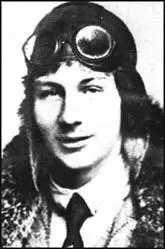Anthony Fokker

Anthony Fokker was born in Java in 1890. When Fokker was twenty-years old he started an aviation company in Wiesbaden, Germany. His first aircraft, Spin I, made a couple of 100 yard flights at the beginning of December, 1910. However, later that month it crashed into a tree and was destroyed. His second aircraft, Spin II, also crashed in May, 1911. His third effort, Spin III, was more successful and in 1913 was purchased by the German military authorities.
On the outbreak of the First World War, Fokker began work on a new single-seater fighter plane. Fokker was convinced that it was vitally important to develop a system where the pilot could fire a machine-gun while flying the plane. His solution to this problem was to have a forward-firing machine-gun synchronized with the propeller.
Other aircraft designers such as Franz Schneider in Germany and Raymond Saulnier in France were also working on the same idea. In the early months of 1915, the French pilot, Roland Garros, added deflector plates to the blades of the propeller of his Morane-Saulnier. The idea being that these small wedges of toughened steel would divert the passage of those bullets which struck the blades.
After the Morane-Saulnier that Roland Garros was flying crashed at Courtrai on 19th April, 1915, Fokker was able to inspect these deflector blades. Fokker and his designers decided to take it one stage further by developing an interrupter mechanism. A cam was attached to the crankshaft of the engine in line with each propeller blade, when the blade reached a position in which it might be struck by bullets from the machine-gun, the relevant cam actuated a pushrod which, by means of a series of linkages, stopped the gun from firing. When the blade was clear, the linkages retracted, allowing the gun to fire.
This synchronized machine-gun was fitted to the Fokker E aircraft. Two other models, the EII and the EIII, that differed in engine-power and wing size to the EI, began arriving on the Western Front during the summer of 1915. These aircraft gave the Germans a considerable advantage over the Allied pilots. German aces such as Max Immelmann and Oswald Boelcke became national heroes as the number of victories over their opponents grew.
In 1917 Fokker and Reinhold Platz began work on a new aircraft. Making use of the advice given by Manfred von Richthofen, the Fokker Flugzeug-Werke company produced the Fokker D-VII. The first of these planes reached the Western Front in April 1918 and by October there were 800 D-VIIs on active service. The Fokker D-VII was strong, fast and superb at high altitudes and was extremely popular with the German pilots.
The quality of the Fokker D-VII aircraft was acknowledged by the terms of the Versailles Treaty. Article IV stated that all these German planes had to be handed over to the Allies. After the war Fokker moved to Holland and took with him 400 engines and the dismantled parts of 120 aircraft from the Fokker Flugzeug-Werke company. In the 1920s the Fokker D-VII became the mainstay of the Dutch air force.
Fokker eventually settled in the United States where he established the Fokker Aircraft Corporation. Anthony Fokker died in 1939.
